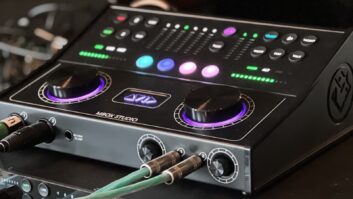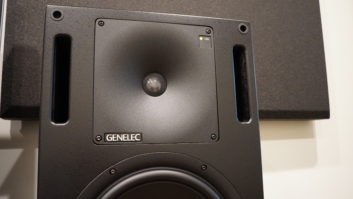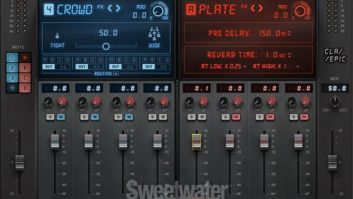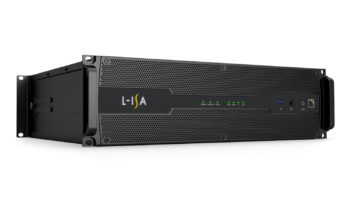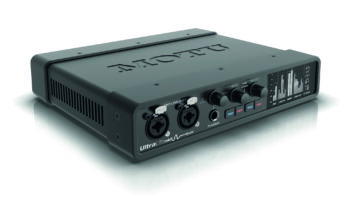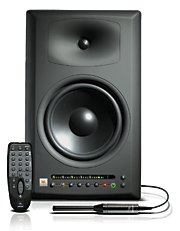
JBL LSR4328P
Every listening space — whether a state-of-the-art control room or a simple basement/bedroom studio setup — has a problem: the laws of physics. As soon as you enclose a space with walls, a ceiling and a floor, the monitoring system’s frequency response goes out the window.
There’s no avoiding this hazard completely (although capable studio design and construction can minimize the damage to the point where it becomes fairly negligible). The presence of parallel room boundaries, such as facing walls or opposing floor and ceiling, causes the build-up and nulling of SPLs at certain frequencies within a room. These peaks and dips, called “room modes,” dramatically skew the frequency response at some places in the room while having little effect at others.
Speaker-boundary effects — caused by the acoustic coupling of speakers to nearby walls, tabletops, shelves or other surfaces — also wreak havoc by arbitrarily boosting bass frequencies. And sound emanating from monitors invariably gets diffracted when it hits the edges of nearby gear and furniture, resulting in comb filtering. What’s worse, these aberrations in frequency response are different for every room and monitor setup, precluding any one-size-fits-all solution.
Splayed walls, vaulted ceilings and various acoustic products (bass traps, diffusers and polycylindrical absorbers) can greatly mitigate many of these problems, but not everybody can afford them. There’s also a limit to what acoustic materials can fix. Truth be told, most of us work in rooms that aren’t flat. Adding to these problems are manufacturing tolerances. Those little plus and minus signs in the frequency response spec show you that due to minute variances in materials and construction techniques, each monitor will have a slightly different inherent frequency response than the others.
Many studio owners use software and outboard EQs to help flatten their monitoring system’s frequency response. Analysis software such as Metric Halo SpectraFoo or EAW’s Smaart can be used to identify the worst room modes (those with the deepest peaks or troughs in response) and speaker-boundary effects for your particular setup. Parametric EQs — placed in the monitoring path — can then be used to boost or cut at frequencies affected by the room modes to bring the response closer to flat. (For reasons too complicated to detail here, only room modes below roughly 200 Hz need to, or should be, treated.) Shelving filters can also be used to roll off any unwanted bass boost caused by speaker-boundary effects.
Recently, a number of monitor manufacturers have bundled analysis software with the onboard digital signal processing in their monitors to accomplish what outboard EQ and third-party software do — and, in some cases, do them much better. Such bundled software essentially measures deviations from linear response for your system — monitors and room — followed by corrective equalization to help flatten the overall response.
To keep the process as simple as possible, some systems automate the routine. The user typically sets up a microphone in the control room, and after a few button-presses/mouse-clicks, the software takes over, automatically handling the rest. There’s no need for you to set up test gear, analyze data and make manual adjustments to EQs; the monitors are intelligent enough to align themselves.
This article examines the current crop of active, self-aligning studio monitors. All the models detailed here operate with included or optional analysis software, along with proprietary automated digital processing. To keep the article focused on the cutting edge, monitors without automatic alignment are not included. Those that simply offer the same switched equalization presets for all production units or don’t use proprietary analysis software are not covered, although the attached “Honorable Mentions” sidebar on page 44 offers a brief discussion of such.
GREAT EXPECTATIONS
Before we dive into the details, we should mention what you can expect from an intelligent monitoring system. Some intelligent systems choose to treat only peaks and not dips in response. In such cases, the argument is that boosting frequencies where room modes cause notches at the reference position is ineffective and will eat up precious system headroom. I believe you can treat notches with EQ boost and get excellent results — if you know what you’re doing. However, most self-aligning systems are designed so that even a novice can achieve great results, a reasonable approach that can provide a significant improvement in system response.
The number and type of filters (e.g., parametric or shelving) included in an intelligent system partly determine how powerful and effective it will be. The quality of the filters plays an enormous role, too; a noisy filter that causes phase shifting does more damage than good. But don’t overlook traditional considerations such as driver size and power specs when shopping. Even the most powerful DSP can’t make a tiny speaker produce enough bass to drive the neighbors nuts. Check out the chart below for these and other important buying considerations.
It’s also important to realize that room modes behave differently at various positions in your room. A room mode that causes a huge dip in response at the mix position may have little or no effect a couple feet away and cause the opposite effect — a huge peak — where your clients are sitting. Therefore, any corrective EQ determined from test measurements taken at your listening position will only fix the frequency response at that location.
Here’s where networked systems really shine: letting the user control all connected monitors from one position — optimally, the listening position. Networked systems typically allow users to store/recall different EQ setups tweaked for various listening positions throughout the room. By toggling through these presets, the producer and clients can, in turn, hear a spectral balance that’s approximately the same as that which the mix engineer hears.
Additionally, networked systems often let the user balance one monitor’s level with respect to another’s, without moving from the sweet spot. The network may also permit tweaking an included subwoofer’s phase to achieve optimal bass response with satellite monitors. Rather than making an adjustment at the subwoofer, it makes sense to do this under network control from your listening position, where you’ll be making decisions about your mixes’ bass perspective.
Attentive readers will notice I haven’t talked about equalization fixes for comb filtering. This is because EQ can’t correct this. Acoustic diffusers are usually used to mitigate comb filtering, but ergonomics at the mix position severely limits their application for combating near-field diffractive effects. Simply put, you can’t move your mixer’s faders if there are diffusers on top of them! That said, Equator Audio Research has devised a time-based solution for comb filtering.
THE CONTENDERS
Listed alphabetically, here are some current offerings in monitoring systems that provide self-correcting capabilities.
Equator Audio’s (www.equatoraudio.com) Q Series of self-correcting, bi-amplified reference monitors includes four different satellite monitors — the Q8, Q10, Q12 and Q15 — and a companion subwoofer, the Q18. The satellites all sport custom coaxial designs that time-align their high- and low-frequency drivers. Before each unit leaves the factory, built-in DSP corrects deviations in frequency response caused by minor variances in materials and manufacturing processes. The company also provides two software programs — one included, the other optional — for use with these monitors.
The software requires you to manually enter your room’s dimensions and speaker positions, then makes some calculations and automatically applies a combination of parametric and shelving filters to help flatten the response. Only the first harmonic for each of the three axial room modes are corrected by default using fully parametric filters. (This is in addition to applying one shelving filter per monitor to correct speaker-boundary effects.) But the software allows you to multiply the default frequencies by whole numbers (e.g., 2x, 3x or 4x) to correct other harmonics that may be stronger than the fundamental and in greater need of correction.
The optional Secondary Reflection Correction™ (SRC) package ($495 list, Mac/Win) takes analysis and correction to a much higher level. It’s a separate and fully automated DSP program that analyzes collected data using an included calibrated microphone. SRC automatically finds the three worst offending (axial) room modes and applies corrective parametric EQ. Advanced users can edit the filters’ settings (including frequencies). Both software packages will by default only treat peaks caused by room modes, but will also allow you to apply boost to notches. Both also allow each speaker to have its own filter settings. (This is especially important for surround setups, as well as stereo setups in an asymmetrical room, as speaker-boundary effects vary with speaker position.)
SRC also automatically identifies and corrects comb filtering caused by secondary reflections, such as those that result from sound bouncing off a mixing console. An adaptive, time-based algorithm (not equalization) treats as many secondary reflections as the software finds. Equator purports that SRC retains a large enough sweet spot so that problems don’t occur as you move your head at the mix position.
SRC’s networking software can optimize the speakers’ combined response for different listening positions, giving your clients seated at the back of the room their own sweet spot. Stereo, 2.1, 5.1, 6.1, 7.1 and 8.2 configurations can be optimized and saved for later recall. You can switch among up to four different saved setups, mixing and matching up to eight satellites and two subs. SRC can also adjust the sensitivity, tone contours (e.g., high-frequency tilt) and speaker grouping (allowing tweaks to groups of monitors at once) for each monitor in the setup. The subwoofer’s output can also be delayed to align it with the satellites.
Genelec (www.genelecusa.com) offers two self-aligning, networked systems that are almost identical but work with different monitors. Genelec Loudspeaker Manager™ (GLM) software works with the DSP chip sets built into the company’s 8240A and 8250A satellite monitors, and 7260A, 7270A and 7271A subwoofers. The Small Environments™ (GLM.SE) DSP system is integral to only the SE7261A sub, but extends its control to up to eight 8130A satellite monitors connected to the sub via single-wire AES/EBU connections.
Both systems use computer-controlled network software packages with nearly identical GUIs. (GLM is Mac/Win; GLM.SE is currently PC-only but will soon also support the Mac.) The systems identify and organize the speakers connected to the network (as stereo or multichannel setups), and control volume, muting and soloing for each speaker. They also include a calibration mic that captures swept test tones produced by the speakers. Genelec’s Auto-Cal software routine then analyzes your room’s response and automatically equalizes the monitors in the system to correct room modes and speaker-boundary effects. Auto-Cal only cuts frequencies when addressing room modes, leaving notches untouched. The software also adjusts subwoofer phase and sensitivity to integrate the sub optimally with satellite monitors in the system.
The main differences between the GLM and GLM.SE systems are the number and type of digital filters available to them and how many loudspeakers they support. The GLM network can support up to 25 main (satellite) monitors and five subs. The system offers four notch filters, two low-shelving filters and two high-shelving filters for each satellite in the system. Each filter can be independently tweaked to a different setting for each speaker. Thus, each satellite can have four room modes equalized and apply shelving filters to both mitigate speaker-boundary effects (using low shelving) and adjust the balance of bass and highs to taste. A sub under GLM control can have four notch filters and a bass roll-off filter applied to its output (in addition to auto-phase and sensitivity adjustments).
Under GLM.SE software control, each of the SE7261A sub’s eight highpass outputs can treat two room modes with notch filters. Located on the 8130’s rear panel are manually adjustable DIP switches for controlling analog filters; the switches remain active and can be used with the GLM.SE’s digital filters. GLM.SE software also adjusts the sub’s phase and level sensitivity for optimal integration with satellites. The GLM.SE software can only address the SE7261A. Both GLM and GLM.SE software can store multiple setups for different listening positions.
You won’t have to get out of your chair to correct your room’s response using JBL’s (www.jblpro.com) LSR4300 Series studio monitors. The three models in this line — LSR4326P and LSR4328P satellites, and LSR4312SP subwoofer — can all be networked for synchronized control from the mix position. Network control extends way beyond just correcting room modes: Speaker-level calibrations, individual-speaker solo, input source selection and all EQ parameters can be adjusted using the system’s included infrared remote control. Or get some exercise and make the adjustments from each speaker’s front panel. The included LSR4300 Control Center Software brings all this functionality under Mac/PC computer control.
You can configure up to two LSR4312SP subs and eight satellites — mixing and matching LSR4326 and LSR4328 units — to create a surround monitoring setup. JBL’s system will automatically align all of the 4300 Series speakers in your setup so that the sound arriving at your mix position sounds balanced. A setup that includes the LSR4312SP sub provides LFE input, bass management for the satellites, adjustable crossover points, and level and polarity calibrations of the sub with respect to the satellites.
Plug the LSR4300 calibration mic into one of the speakers in your setup, and, at the push of a button, JBL’s Room Mode Correction™ (RMC) system will automatically analyze and correct peaks in frequency response caused by room modes. The system doesn’t merely analyze response at a single on-axis point in the room, but takes omni-directional measurements to better match what the engineer hears. Seventy-two measurements are taken, including those of the direct, reflected and reverberant sound fields. Only peaks caused by room modes between 20 and 160 Hz are treated; notches in response are left untouched. RMC can also address speaker-boundary effects, but room modes get priority treatment.
Each speaker — including the LSR4312SP sub — can correct one room mode using a parametric filter set to any of 73 frequencies. Each speaker’s filters can be set independently of those for the other monitors in the system. The filters are on 1/24-octave centers and offer Q values from 1 to 16. The LSR4326 and LSR4328 each provide HF and LF shelving filters that can be manually tweaked to tailor spectral balance.
GET SMART
Self-aligning monitors are here to stay and will become more powerful as studio pros become more comfortable with — and enamored by — the technology. However, current systems do have their limitations. Room modes are powerful forces that don’t easily yield to equalization. Correcting comb filtering is even more challenging. Even the most intelligent system won’t produce a perfectly flat frequency response, but it should be a lot closer than what a standard monitoring setup can provide. The result will be greatly increased accuracy in your monitoring chain that should translate to better mixes. Sure sounds like a smart investment to me.
INTELLIGENT STUDIO MONITORS, AT A GLANCE
HONORABLE MENTIONS
Some manufacturers offer systems that don’t self-align but include analysis software or customized DSP solutions to help flatten frequency response.
JBL Professional‘s first-generation RMC (Room Mode Correction) monitor — model LSR 6328SP — is not auto-correcting, but can correct for room modes in any particular room after running a manual 30-minute setup procedure. The optional LSR6312SP subwoofer includes the RMC kit and provides RMC capability when used in 2.1 or 5.1 systems with JBL’s LSR6332 and LSR6325P models.
Klein + Hummel (www.klein-hummel.com) and KSdigital (www.ksdigital.de) offer monitors that use Finite Impulse Response (FIR) filters, which preserve phase linearity while adjusting frequency response. Neither company offers analysis software, but each provides room-correction software that is implemented in a similar fashion. You’ll need to “shoot” (gather test data for) your room yourself or hire a specialist to do so, using third-party hardware and/or software. You then send your test measurements to the company and they send you a data-set containing corrective equalization, which uploads into nonvolatile memory inside the monitor(s). Note that the 0 500 C digital active main monitor is currently the only Klein + Hummel model that uses this type of technology.
Tannoy‘s (www.tannoy.com) Activ-Assist (Mac/Win) software measures the frequency response of your setup comprising the company’s Precision or Reveal Series monitors. The software then suggests settings for the monitors’ cabinet-mounted DIP switches, which provide fixed-equalization presets fashioned to correct typical speaker-boundary effects. The filters must be set manually and are too broad in action to correct room modes (which was not the manufacturer’s intent).
For those who want to take an a la carte approach, several new, out-of-speaker solutions are available — such as IK Multimedia‘s (www.ikmultimedia.com) ARC and KRK‘s (www.krksys.com) Ergo. These systems work with a wide variety of monitors, allowing users to turbo-charge their existing setups with the latest technology. If you’re mostly pleased with the performance/sound of your current monitors, systems such as these provide an affordable alternative.
Mix contributing editor Michael Cooper has written more than 300 articles about pro audio during the past 20 years. Visit him at www.myspace.com/michaelcooperrecording.
